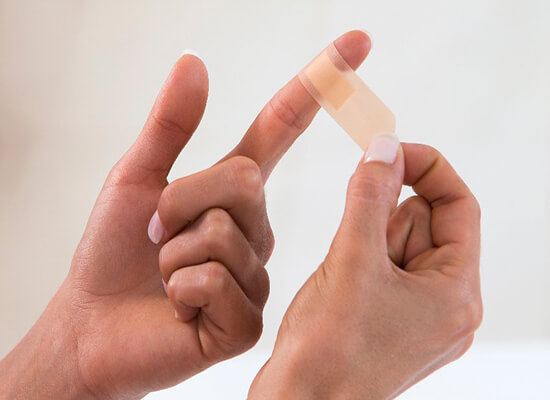
Small Wounds and Cuts and When to See a Doctor
Definition
Minor wounds can easily be cared for without seeing a medical practitioner and usually take a short time to heal. A small wound can come from a cut, blister, scrapes, etc. They bleed a little bit and form a scab, the body's self-healing mechanism for preventing the entry of dirt and germs before regenerating new skin.
Causes of small wounds and cuts
Various things could cause small wounds on the body. Often, it is the body's way of reacting to unusual contact with an organism, item, etc. Some common causes of small wounds include allergic reactions, fungal or bacterial infections, insect bites, small cuts, etc. At times, the wounds may appear on the body as one of the signs and symptoms of another disease. For example, one may develop small wounds around the mouth before catching a cold or the influenza virus.
Nevertheless, the causes for small wounds can range from mild to severe. For example, minor wounds such as sores may appear on the body occasionally or frequently. The frequency of occurrence usually may be an indication of a severe underlying infection that needs medical attention.
Depending on the cause, small wounds can be open or hard bumps or filled with fluid. When either is broken, there could be slight bleeding. Sores may also form to show limited blood flow in the area. For example, the frequent use of a wheelchair or extended periods of bed rest may result in fever blisters or pressure sores.
Treatment
Ideally, the body should be able to manage small wounds naturally. The body has red blood cells, which contribute significantly to forming new skin tissues. Essentially, these cells aid in the creation of collagen- tough white fibers- that fill the broken area forming a tissue known as granulation tissue. It creates a foundation for new skin to develop gradually, and the wound slowly disappears. For this process to occur efficiently, your body may need essential nutrients such as zinc, Vitamin A and C, protein, and a lot of fluid.
If not correctly cared for, small wounds can quickly become big and pose a risk to the general wellness of the rest of the body. It is therefore essential to use the basic first aid steps on minor wounds to minimize the potential of further infection.
Here are the core first aid guidelines on how to treat small open wounds such as cuts and scrapes:
Wash your hands- wounds, whether small or big, are at a high risk of contamination; therefore, cleaning your hands by washing helps prevent further infection.
Clean the wound- rinse off the wound (for cuts) with cool running water to rid it of dirt or debris. Using other solutions such as alcohol and iodine is not advisable as they may further irritate the area.
Stop the bleeding- minor wounds should stop bleeding within a short time. However, If bleeding persists, apply a bit of pressure with a piece of cloth or gauze until the bleeding stops.
Apply wound healing ointment or petroleum jelly- a thin layer of petroleum jelly or ointment may prevent scarring while keeping the area moist. Take caution by reading through the ingredients list when using antibiotic ointments. Some may be too harsh, causing further irritation.
Cover the wound- A small band-aid, bandage, or rolled gauze secured with paper tape helps prevent additional dirt entry. Covering the wound also preserves moisture, essential in keeping the cells alive. However, most small wounds should remain uncovered and undisturbed to let them heal naturally by forming a scab. Also, note that any wound should remain undisturbed as it heals.
Regularly change the dressing- dressed wounds should be kept clean by removing dirty or wet dressing at least once daily.
Get the tetanus shot- A tetanus vaccine is crucial for the body as it helps it make antibodies that promote immunity against toxins often produced by bacteria. Lack of which, open wounds such as cuts- small or big- put you at risk of acquiring the bacteria, which can be fatal if not treated.
You can aid the process by taking a lot of water and eating healthy foods or supplementary multi-vitamin drugs. Some home remedies such as aloe Vera could also help stop the bleeding and speed up the healing process.
When to See a Doctor
Small wounds are often easily manageable from home; however, it may be safer to consult a doctor depending on several factors. You should see a doctor if:
The wound is on sensitive areas such as the face or genitals.
The wound, usually cuts, punctures, and piercings, is deep enough to expose the fat muscles.
You are unable to clean the wound properly on your own.
The wound was caused by rusty items or from an animal or human bite.
You have not had the tetanus vaccination in five years or more.
The area goes numb.
Additionally, you should seek medical attention when the wound is accompanied by other symptoms such as redness, swelling, increased itching and pain, fever, red streaks, unusual drainage, or too much puss. These symptoms could be an indication of underlying health issues.
Prevention
Generally, wounds could be the result of an accident or unhealthy habits. Therefore, the best way to take precautions is by avoiding hazards such as sharp objects and fire or following safety guidelines when exposed. Other helpful measures include drinking enough water to keep the body hydrated. Practicing hygiene habits and proper skin care routines, eating healthy –meals rich in nutrients that boost the body's immunity, and staying active or exercising regularly.
Additionally, it would help to avoid other habits such as smoking and following the doctor's instructions when managing other health conditions. These conditions could prolong the healing process for all wounds due to compromised immunity. Frequent recurrent wounds should prompt a visit to the doctor. Take extra caution on products such as antibiotics and ointment used on wounded areas as the ingredients may spark allergic reactions. Finally, always follow the doctor's instructions to the letter, even for minor wounds.




